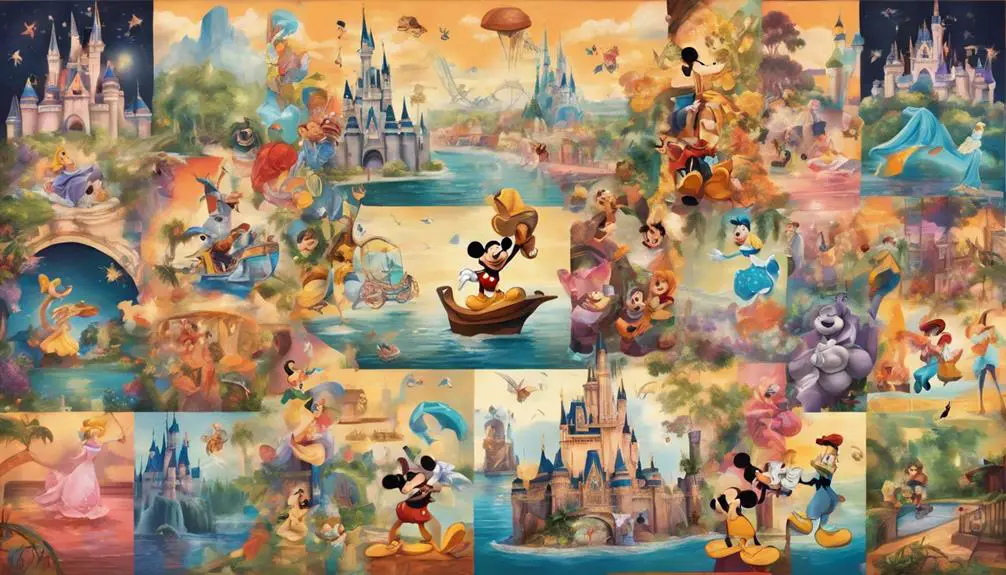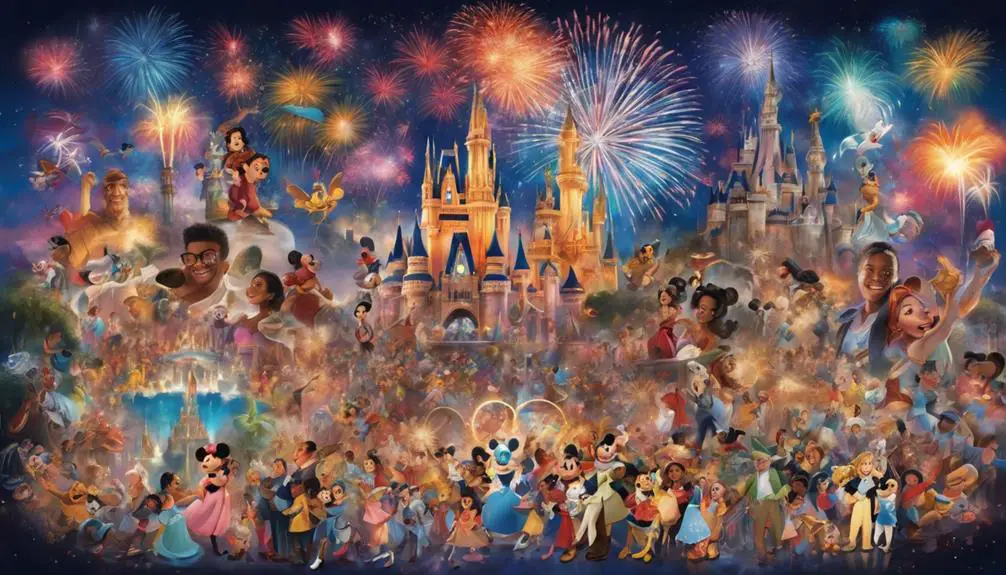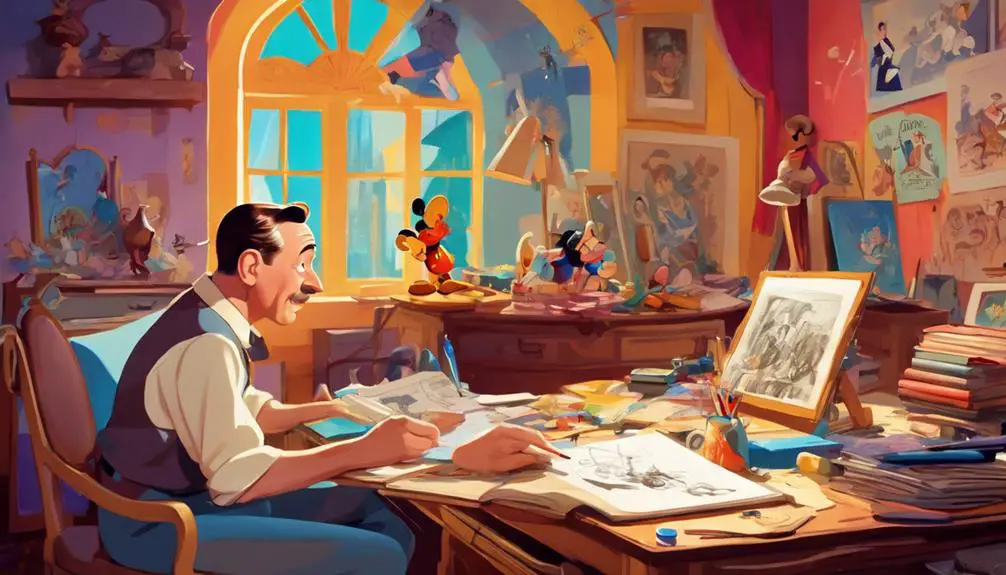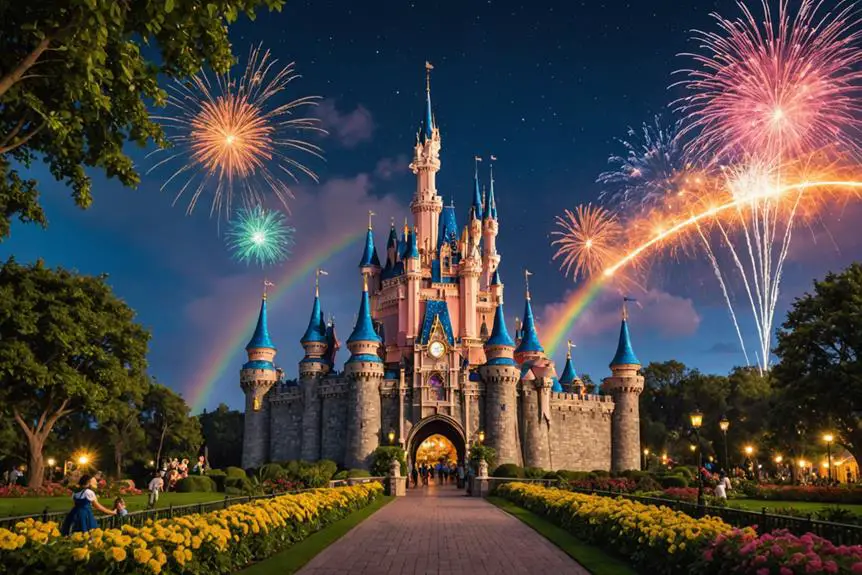Disney represents a vibrant blend of entertainment, culture, and history. You might be surprised to learn that the name traces back to a French village called Isigny. Its evolution reflects deep roots in European culture and heritage. Today, Disney's impact goes beyond movies, creating immersive experiences in theme parks and fostering family traditions. The word "Disneyesque" captures its whimsical charm, while timeless stories like "Snow White" set standards in animation. Disney not only entertains but also shapes our understanding of storytelling and social values. Stick around, and you'll discover even more about this fascinating cultural phenomenon!
Other Word Forms of Disney

When you think about "Disney," several related terms come to mind that expand its meaning. One of those is "Disneyesque," an adjective that captures the essence of Disney's whimsical and family-friendly charm. You might find it used to describe anything that embodies the magic and imagination found in Disney films, whether it's a theme park ride or a brightly colored children's book. This word highlights how deeply ingrained Disney's style is in our culture.
Another important aspect is the influence of Disney resorts. These destinations don't just serve as places for vacations; they create immersive experiences that transport you into the heart of beloved stories and characters. The resorts play a significant role in the broader cultural impact of Disney. They offer visitors a chance to engage with the brand beyond just watching movies or buying merchandise, allowing families to create lasting memories together.
In academic discussions, the term "Disney" often comes up as a cultural touchstone. Scholars explore its impact on storytelling and character development, particularly in children's literature and media. You can see how Disney shapes narratives that resonate with young audiences, fostering imagination and reinforcing family values.
Ultimately, the various forms of "Disney"—from its singular name to the plural "disneys"—illustrate its far-reaching influence on entertainment, culture, and society as a whole. The way these terms interconnect reveals just how significant Disney really is in our lives.
Origin of the Name
The name "Disney" carries a rich history that goes beyond its modern association with entertainment. You might be surprised to learn that the surname "Disney" originates from the Old French placename "Isigny," located in Calvados, France. This historical link to a specific place highlights the deep roots of the name in European culture.
"Isigny" itself has fascinating origins. It derives from the Gallo-Romance personal name "Isinius," which traces back to a Latinized version of the Gaulish name "Isina." This connection reveals how names evolve over time, influenced by language and migration.
When you think of "Disney," you may picture Walt Disney, the iconic figure who transformed the entertainment landscape, but his surname reflects a lineage steeped in Norman history.
Understanding the surname "Disney" allows you to appreciate the blend of culture and history that it represents. The name isn't just a title; it encapsulates a journey through time, from a small place in Calvados to the global phenomenon it's today.
The evolution of the surname shows how the influences of the past shape our present, especially in the context of family entertainment.
Cultural Impact of Disney

Shaping American culture, Disney has become synonymous with family entertainment, creating a legacy through its beloved characters and timeless stories.
With the opening of Disneyland in 1955 and Disney World in 1971, the company revolutionized the theme park industry, making immersive experiences a key part of family vacations. This shift not only changed how families spent their leisure time but also set the stage for future theme parks to prioritize storytelling and engagement.
Disney films have also left an indelible mark on cultural storytelling. Classics like "Snow White and the Seven Dwarfs" not only captivated audiences but also influenced the animation industry, establishing a standard for narrative and artistic quality.
The company's extensive merchandise and branding strategies further extend its cultural reach, embedding its characters into everyday life.
Some key aspects of Disney's cultural impact include:
- Timeless Characters: Iconic figures like Mickey Mouse and Cinderella resonate across generations.
- Family Values: Disney promotes messages of kindness, perseverance, and friendship.
- Nostalgia: Disney evokes childhood memories, making it a central topic in discussions about media influence.
Through its films, theme parks, and merchandise, the cultural impact of Disney is undeniable.
It's not just about entertainment; it's about creating shared experiences that bring families together, making Disney a cherished part of American culture for generations to come.
Disney in Language and Literature
Disney's influence extends beyond films and theme parks; it permeates language and literature, making it a familiar reference in countless narratives. In children's literature, Disney often embodies themes of magic, adventure, and moral lessons. This makes it a staple in educational settings where you and your peers explore these enriching stories. When you hear the term "Disney," you recognize it as a cultural touchstone, symbolizing the intersection of entertainment and social values.
Disney's impact on storytelling techniques is significant. Many academic discussions highlight how its narratives have shaped modern literature and media. You might notice that the vocabulary related to Disney has even evolved; terms like "Disneyesque" describe works that echo the enchanting style and storytelling found in Disney's creations. This incorporation of Disney characters into various forms of media emphasizes the brand's vast influence on language and cultural references.
Moreover, Disney vacation resorts often serve as a backdrop for storytelling, where visitors immerse themselves in the magic of Disney narratives. These experiences enrich your childhood vocabulary, filling it with references that resonate with adventure and joy.
Walt Disney's Legacy

Walt Disney revolutionized the entertainment landscape, leaving an indelible mark that continues to resonate today. His visionary ideas transformed not just animation but also how families experience entertainment.
You're likely familiar with his iconic characters, like Mickey Mouse, who first danced on screen in "Steamboat Willie." This groundbreaking film in 1928 was the first to feature synchronized sound, setting the stage for future innovations.
Walt's ambition didn't stop at animation. He introduced vibrant color to cartoons with "Flowers and Trees" in 1932 and brought storytelling to life in 1937 with the release of "Snow White and the Seven Dwarfs," the first-ever feature-length animated film.
Furthermore, Walt Disney's legacy extends into the domain of themed experiences. He created Disneyland in 1955, a revolutionary concept that shaped the vacation resorts operated by Walt Disney.
Consider these key elements of his legacy:
- Innovative Storytelling: Walt's unique approach to storytelling transformed animation into a respected art form.
- Cultural Impact: His characters and films have become an integral part of global culture, influencing generations.
- Theme Park Vision: The parks he envisioned continue to be world-renowned destinations for family entertainment.
Walt Disney's influence is undeniable. His creative spirit lives on, inspiring countless artists and entertainers, ensuring that his legacy will thrive for years to come.




